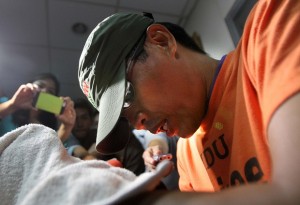MANILA, Philippines—Police Officer 2 Edgar Angel, the alleged gunman in the killing of Enzo Pastor, recanted on Monday his earlier statement that he was behind the slay of the racecar driver.
Angel, who earlier tagged businessman Domingo “Sandy” De Guzman and Pastor’s wife Dalia Pastor as the brains behind the crime, withdrew his extrajudicial confession, saying he was threatened by members of the Crime Investigation and Detection Unit to own up to Pastor’s killing.
His recantation surprised many, most especially the family of Pastor who had hoped that his admission would finally give justice to the car racer.
Just like in Pastor’s case, other high-profile cases have also taken a huge blow from the recantation of witnesses and perpetrators who would have provided key statements to their resolution.
NIDA BLANCA CASE
Pedro Philip Medel Jr., confessed to killing movie actress Nida Blanca in November 2001. He had turned himself in, claiming he was “bothered by his conscience.” He said that Rod Strunk, Blanca’s American husband, through a certain Mike Martinez contracted him to torture Nida into producing a document related to her Will.
But just days after his confession, Medel broke down and claimed to have been tortured by police into admitting to the crime and naming Strunk as the mastermind.
The Philippine National Police flatly denied Medel’s claim of torture. But officials of its Task Force Marsha admitted that Medel’s recantation had put his confession in doubt, and that they had no other evidence to pin him down for the killing.
Nonetheless, in February 2003, the Department of Justice indicted Strunk as the brains behind the murder of Blanca on the strength of the handwritten confession of Medel. The preliminary investigation of a two-man panel of the DOJ established that Strunk indeed ordered Medel to kill Blanca. Strunk and Medel, along with a Jane Doe, were charged with murder at the Pasig City RTC.
Strunk though managed to leave for the US to visit his ailing mother, Helen Strunk, who was dying of cancer, before he could be charged. She died on Jan. 20, 2002 and Strunk never returned to the Philippines.
In May 2003, however, federal agents, acting on an extradition request from the Philippine government, arrested Strunk and placed him in the Sacramento County Jail pending an extradition hearing.
But a US federal court later threw out the extradition request because Philippine authorities failed to establish Strunk’s guilt after Medel’s recantation. Strunk was then ordered released from jail.
Strunk died in July 2007 after falling from a two-story inn in Tracy, California, in what the police there ruled a suicide.
In April 2010, Medel died from “sepsis (blood poisoning) secondary to pneumonia” after a two-day confinement in the medicine ward of the Pasig City General Hospital. Medel had been detained since 2005 in the Pasig City Jail in Barangay Pinagbuhatan, where he was committed and transferred from the custody of the National Bureau of Investigation. He carried to his grave what could be the only hope of finding out who really killed Nida Blanca.
KURATONG BALELENG RUBOUT
In March 1999, Quezon City Regional Trial Court Judge Wenceslao Agnir Jr. dismissed the murder charges against all defendants in the Kuratong Baleleng rubout case after the recantation of principal witnesses.
The case started on May 17, 1995 when the police rounded up 11 suspected members of the bank robbery syndicate Kuratong Baleleng. Early the next day, all 11 men were dead in what lawmen said was a shootout on Commonwealth Avenue, Quezon City. But witnesses subsequently said the 11 were killed in a rubout.
SPO2 Eduardo de los Reyes filed a sworn statement claiming he was part of a police team—known then as the Anti-Bank Robbery and Intelligence Task Force Group—that arrested the 11 and that was later ordered to summarily execute them. Another investigator, SPO2 Corazon De La Cruz, corroborated this.
Armando Capili, a reporter of the tabloid Remate Tonite, said he saw police leading eight men with bound hands from a safehouse at No. 14 Palm St. in Superville, Parañaque City.
Jane Gomez, niece of alleged Kuratong leader Wilson Soronda, claimed that on May 17, agents of the Presidential Anti-Crime Commission then chaired by Vice President Joseph Estrada, took from Soronda, among others, an attaché case and a suitcase containing $2 million and P25 million.
In March 1996, Ombudsman Aniano Desierto charged before the Sandiganbayan 11 police officers as principals and 15 others, including then Chief Supt. Lacson, as accessories to the murder of the suspected Kuratong members. The case was transferred to the Quezon City RTC after the Supreme Court upheld Lacson’s petition questioning the Sandigan’s jurisdiction over the case.
Capili was the first to recant in December 1997, followed by Gomez in January 1998. De los Reyes and De la Cruz recanted that same year.
In January 2013, the Supreme Court dismissed with finality the multiple murder case filed against Senator Lacson and 33 other police officers in connection with the 1995 operation against the Kuratong Baleleng gang.
RELATED STORIES
